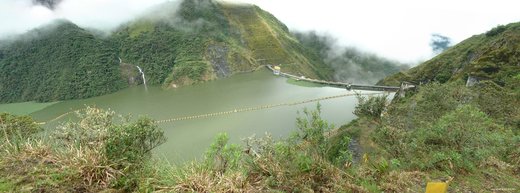19 February 2014
China’s growing influence in Africa has fascinated the world’s press for a decade now. What is less well known is that it is also becoming a force in Latin America. China has passed the US as the main trading partner of Brazil, Chile and others. Indeed, by some calculations, trade between China and the countries of Latin America reached $250bn in 2012, compared with $200bn with Africa.
One area where Chinese civil engineering is changing the landscape is hydroelectric power.
According to International Rivers, an NGO that keeps a critical eye on dam building around the world, China is involved in 22 projects, of which three are complete, seven under construction and 12 in the proposal stage.
With the exception of two completed schemes in Belize, all these projects began after 2010, and really gained momentum in 2012.
The seven dams under construction are in Costa Rica, Ecuador and Honduras. They will have a total installed capacity of 2,087MW and will cost more than $2.5bn.
By far the largest of these projects is the Coca Codo Sinclair dam being built by Sinohydro and financed by a 15-year, $1.7bn loan from the Export-Import Bank of China.
It is also one of the most controversial, as environmentalists claim that it will dry up Ecuador’s iconic San Rafael waterfall. The Ecuadorian government responds that when it is completed in 2015 it will supply 1,500MW, or about 44% of the country’s electricity needs.
The 12 proposed hydropower projects are in Costa Rica, Ecuador, Guyana, Honduras, Peru and Argentina, with a total installed capacity of 5,000MW.

The 160MW Paute dam, presently Ecuador’s largest, will be dwarfed by the 1,500MW Coca Codo Sinclair
The total budget, which includes funding from Latin American sources, is more than $12.3bn, according to International Rivers.
As with China’s Africa infrastructure projects, it is the ability of state-owned construction firms to raise finance from state-owned banks that makes the Chinese construction machine such so formidable. The Shanghai-based Sinohydro Corporation alone holds a 50% share of the global hydroelectric market.
It has also benefited from South American countries’ desire to break the near monopoly of giant Brazilian firms such as Odebrecht and Andrade Gutierrez. In the case of Ecuador, which has become the main recipient of Chinese capital, fears have been raised over the long-term effect of the country’s sovereignty.
Paulina Garzon, a co-ordinator of the Ecuadorian Centre for Economic and Social Rights, said at least half of the $10bn in loans provided by China to Ecuador since 2009 had been earmarked for hydro projects. The loans are to be repaid with oil.
The projects also have a political benefit for China. Patricia Adams, executive director of Canadian watchdog Probe International, told The South China Morning Post that Chinese firms had displaced rivals from Taiwan to build three dams in Honduras.
She added: “There is great resistance to dam-building in Latin America and special worry about Chinese dams because of the opaque nature of China’s decision-making and poor quality in these dams. The construction industry is more plagued by corruption than any other and China’s dam-building industry is well known for corruption.”
Meanwhile, a Chinese-led consortium has won a contract to construct the transmission system for Brazil’s Belo Monte dam complex on the Xingu River -the first direct current ultra-high-voltage line in Brazil.
The group, which is made up of China State Grid and Brazil’s own Eletrobras, will have to finance and build two conversion stations, a pair of substations and 1,300-miles of transmission wires connecting Altamira in Par with Estreito in Minas Gerais in the south, an infrastructure investment with an estimated cost of $2bn.
A spokesperson for International Rivers told China Daily that the Belo Monte dam “is the most destructive and controversial dam being built in Brazil currently, perhaps in the world”.










